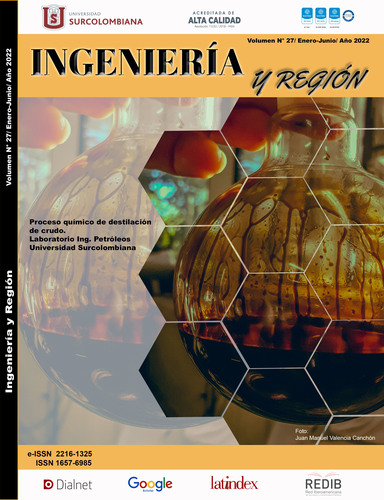Evaluation of the semi-dry benefit process (Honey) in the varieties of Coffee (Coffee arabica) Castillo, Colombia and Caturra and its effect on cup quality
##plugins.themes.bootstrap3.article.main##
A comparison was made with respect to the cup quality for samples in three varieties of coffee (Coffee Arabica) which were processed through two types of process: Wet (T1) and Semi-dry-Honey (T2); The coffee fruits were harvested in two different stage 20 days apart at the Bellavista farm located in the Pantanos village of the Timaná Huila municipality. The samples were brought to a humidity within 10-12% in two different structures for the solar drying process, where the conditions of relative humidity and temperature were monitored. Subsequently, each sample was stored for a month and then sensory analysis was performed. The information recorded in this research allows to conclude that the coffee processing method does not the total score in cup, for the Castillo, Caturra and Colombia varieties, the mean value for the T1 per variety was 83,46; 82 and 80,84 respectively; For T2 they were 82,87; 82,56 and 82,15; Therefore, both treatments could be defined as specialty coffees.According to the classification proposed by the SCAA, it is also found that the best variety to obtain a rate score applying either of the two process methods is the Castillo variety, since this variety was superior with respect to the other two for the two types of process.
Downloads
##plugins.themes.bootstrap3.article.details##
Arcila, J., Farfán, F., Moreno, A., Salazar, L., & Hincapié, E. (2007). Sistemas de producción de café en Colombia . Chinchiná, Caldas: FNC-Cenicafé.
Asoexport. (2013). Tipos de café y superficie sembrada. Obtenido de http://www.asoexport.org/tipos_cafe.html
Boyacá, L. A. (2018). Estudio exploratorio de la obtención de café verde mediante beneficio Honey y la determinación de su calidad en tasa. Bogotá, Colombia : Universidad Nacional de Colombia.
Carvajal Herrera, J. J., Aristizábal Torres, I. D., Oliveros Tascón, C. E., & Mejía Montoya, J. W. (2011). Colorimetría del Fruto de Café (Coffea arabica L.) Durante su Desarrollo y Maduración. Rev.Fac.Nal.Agr.Medellín , 6232.
Córdoba, N., & Guerrero, J. (2016 ). CARACTERIZACIÓN DE LOS PROCESOS TRADICIONALES DE FERMENTACIÓN DE CAFÉ EN EL DEPARTAMENTO DE NARIÑO. Biotecnología en el Sector Agropecuario y Agroindustrial, 75-81 . DOI:10.18684/BSAA(14)75-83
Correa, P., Resende, O., & Deise, R. (2006 ). DRYING CHARACTERISTICS AND KINETICS OF COFFEE BERRY . Revista Brasileira de Produtos Agroindustriais, 1-10 . DOI: http://dx.doi.org/10.15871/1517-8595/rbpa.v8n1p1-10
Craig, A., Franca, A., & Oliveira, L. (2012). Discrimination between defective and non-defective roasted coffees by diffusereflectance infrared Fourier transform spectroscopy. LWT - Food Science and Technology, 505-511. https://doi.org/10.1016/j.lwt.2012.02.016
DonFrancesco, B., Nelson, G. N., & Chambers, E. (2014). Comparison of Results from Cupping and Descriptive Sensory Analysis of Colombian Brewed Coffee. Journal of Sensory Studies , 301-311.
https://doi.org/10.1111/joss.12104
Federación Nacional de Cafeteros. (1997). Sistema de información cafetera. Encuesta Nacional Cafetera, SICA. Santafe de Bogotá: Federacafé.
Ghosh, P., & Venkatachalapathy, N. (2014). Processing and Drying of Coffee – A Review . International Journal of Engineering Research & Technology (IJERT), 784-794.
INEM. (2012). CAFÉ VERDE. DETERMINACIÓN DE LA PÉRDIDA DE MASA A 105°C . Obtenido de NTN INEN-ISO 6673:2012: https://www.normalizacion.gob.ec/buzon/normas/nte_inen_iso_6673.pdf
Martínez, V. M., Aristizabal, I. D., & Moreno, E. L. (2017). EVALUATION OF THE COMPOSITION EFFECT OF HARVESTED COFFEE IN THE ORGANOLEPTIC PROPERTIES OF COFFEE DRINK. FACULTAD DE CIENCIAS FARMACÉUTICAS Y ALIMENTARIAS , 47-58. https://doi.org/10.17533/udea.vitae.v24n1a06
Oliveros, C., Peñuela, A., & Jurado, J. (2009 ). Controle la humedad del café en el secado solar, utilizando el metodo GRAVIMET. Avcances tecnicos Cenicafe, 1-8 .
Oliveros, T., A., R. C., Sanz, J. R., & Peñuela, A. (2006). Secador solar de túnel para cafe pergamino. Avances tecnicos Cenicafe, 1-8.
Parra, A., García, O., Vanegas, F., Gamboa, J., & Gonzalez, A. R. (2020). Preliminary study of drying of natural coffee by cyclical pressure changes. Revista DYNA, 53-60. https://doi.org/10.15446/dyna.v87n214.83414
Peñuela, A. E. (2010). ESTUDIO DE LA REMOCION DEL MUCILAGO DE CAFE A TRAVEZ DE FERMENTACION NATURAL. Obtenido de https://ridum.umanizales.edu.co/xmlui/bitstream/handle/20.500.12746/1072/Pe%C3%B1uela_Martinez_Aida_Esther_2010.pdf?sequence=1&isAllowed=y
Pereira, G., Carvalho, D., Magalaes, A., Vásquez, Z., Medeiros, A., Vandenbergue, L., & Soccol, C. (2019 ). Exploring the impacts of postharvest processing on the aroma formation of coffee beans – A review. Food Chemistry , 441-452. DOI: 10.1016/j.foodchem.2018.08.061
PERFECT DAILY GRIND . (28 de Agosto de 2017). ¿Cómo Mejorar la Calidad al Secar Cafés Lavados? Obtenido de https://perfectdailygrind.com/es/2017/08/28/como-mejorar-la-calidad-al-secar-cafes-lavados/
Puerta, G. (2016). Calidad física del café de varias regiones de Calidad física del café de varias regiones de Calidad física del café de varias regiones de. Cenicafé, 7-40.
Puerta, G. I. (2012). Factores, Procesos y Controles en la Fermentación del Café. Avances técnicos Cenicafé, 4-12.
Quintero, G. I. (2009). Efecto de las enzima Pectolíticas en la remoción del mucílago de Coffea arabica L., según el desarrollo del fruto. Cenicafé, 283-304.
Ramos, L. J., & Criollo, H. (2017). Calidad física y sensorial de Coffea arábica L. variedad Colombia, perfil Nespresso AAA, en La Unión, Nariño. REVISTA DE CIENCIAS AGRÍCOLAS, 83-97 .
Rodriguez, Y., Guzman, N., & Hernandez, J. (2020). EFFECT OF THE POSTHARVEST PROCESSING METHOD ON THE BIOCHEMICAL COMPOSITION AND SENSORY ANALYSIS OF ARABICA COFFEE . Engenharia Agrícola, 177-183. DOI:10.1590/1809-4430-eng.agric.v40n2p177-183/2020
Rosales, C. P. (Octubre de 2016). Efecto del proceso de secado en las características físico-químicas y sensoriales de café especial (var. Pacamara). Obtenido de https://bdigital.zamorano.edu/bitstream/11036/5769/1/AGI-2016-T024.pdf
SCAA. (21 de Noviembre de 2009A). Grading Green Coffee. Obtenido de SCAA Protocols: http://www.scaa.org/PDF/resources/grading-green-coffee.pdf
SCAA. (16 de Diciembre de 2015). Cupping Specialty Coffee . Obtenido de SCAA Protocols: http://www.scaa.org/PDF/resources/cupping-protocols.pdf
Siagian, P., Setyawan, E., Gultom, T., Napitupulu, ,. F., & Ambarita, H. (2017). A field survey on coffee beans drying methods of Indonesian small holder farmers. Nommensen International Conference on Technology and Engineering, 1-7. DOI:10.1088/1757-899X/237/1/012037
Zambrano, D. (1992). La economía del agua como perspectiva para controlar contaminación durante el lavado de café. Notas del seminario cientiffico presentado el 11 de noviembre de 1992. Chinchiná, Caldas: Cenicafé.
Zambrano, D., & Rodríguez, N. (2008). Sistemas para el tratamiento de aguas mieles: Investigación aplicada en beneficio de los productores cafeteros. Disciplina de Calidad y Manejo Ambiental. Chinchiná, Caldas: Cenicafé.





 Perfil Google Scholar
Perfil Google Scholar













